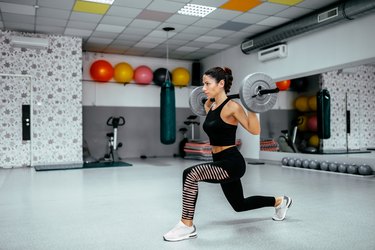
Toning muscle is a term that refers to the building of the muscle. When looking to build muscles of the upper thigh, there are various exercises for above the knee that work the quadriceps and hamstrings. Strength training these muscles will help to build shapely, strong legs.
Read more: 10 Minute Leg Sculpting Workout
Video of the Day
Video of the Day
Building Muscles Above the Knee
The area of the leg above the knee is typically called the thigh. The thigh muscles consist of the quadriceps and hamstrings, among others. The term toning muscle is used typically to describe the tighter and more firm feeling that occurs when someone builds muscle and is lean. The physiological effects of building and toning muscle are the same since toning is not a technical term.
Many people believe that toning creates smaller, more lean muscles, while building muscle creates bulk — a fear of some women who are strength training and do not wish to look bulky. Muscle is compact, however, and women have a tough time gaining bulk due to a lack of testosterone. To reduce the effect of looking bulky while gaining muscle, one only has to lose any excess fat that is covering the muscles.
Strength training your thighs will help them become shapely, strong and most importantly, functional in your daily activity. There is no reason to lift light weights for many repetitions to try and avoid getting too bulky.
The American Council on Exercise (ACE) recommends strength training for the following benefits:
- Increased bone, muscle and connective tissue strength, which decreases the risk of injury.
- Increased muscle mass that helps to negate the effects of muscle loss as we age.
- Increased metabolism compared to an untrained state, and the prevention of decreased metabolism due to aging. This is because muscle is a metabolically active tissue that helps to increase your metabolic rate.
- A higher quality of life. Daily activities will be less of a burden with increased strength and performance.
Exercises for Above the Knee
Many exercises can strengthen and build muscle in your thighs. Some of the most common and popular are various squat and lunge variations.
You can use free weights such as barbells, kettlebells or dumbbells, or you can use your bodyweight for these exercises, especially if you are a beginner. The Mayo Clinic says that bodyweight training, which is using only your body as resistance, is a useful type of strength training. The Mayo Clinic recommends exercises such as lunges and squats, keeping movements smooth and controlled.
Move 1: Back Squat
The back squat exercise targets mainly your quadriceps and glutes, and your hamstrings, calves and core muscles as stabilizers.
- With a barbell in a rack, leveled just below shoulder height, dip under the bar placing it across the top of your back behind your neck. Grip the bar just slightly wider than shoulder-width.
- With your chest lifted and shoulder blades squeezed together behind your back, stand up to bring the bar off the rack and take a step back.
- With your feet slightly wider than shoulder-width, hinge back as if you're sitting into your hips while allowing your knees to bend forward. Keep your back straight throughout the whole movement while your chest remains up.
- Squat until your thighs are just below parallel as far as your range of motion will personally allow.
- Press your feet into the ground as you push your hips forward, and extend your knees until your legs are straight to return to the top of the motion.
Move 2: Forward Lunge
The forward lunge targets the quadriceps, gluteus maximus, adductors and soleus calf muscles. The hamstrings, calves (gastrocnemius) and core muscles act as stabilizers.
- With a barbell in a rack, leveled just below shoulder height, dip under the bar placing it across the top of your back behind your neck. Grip the bar just slightly wider than shoulder-width.
- With a chest lifted and shoulder blade squeeze together behind your back, stand up to bring the bar off the rack and take two steps back.
- Standing with feet hip-width apart, step forward with your right leg, landing on your heel first and then your forefoot, flexing your knee and hip of the front leg while lowering your left knee until it almost touches the floor. Keep an upright torso position during the entire movement.
- Push your right foot into the ground and pulled back with the left leg to stand up to the starting position. Inhale.
- Switch legs and repeat for the desired number of repetitions.
Other squat variations include the front squat, goblet squat, split squat and sumo squat. Alternative lunge variations to try include a lateral lunge and a backward lunge.
As mentioned previously, when desiring a toned look in the legs, most people are referring to lean and firm. Strength training on its own can induce weight loss, yet studies show that the best exercises for above the knee that will result in toning include a combination of cardiovascular aerobic training and resistance training, according to a May 2017 review published in the New England Journal of Medicine.
You can combine cardiovascular and strength-training exercises for above the knee by performing strength circuits with little rest, which keeps the heart rate up. You can also try plyometric exercises. Include forward or lateral jumps, squat jumps, switch lunges, skaters and mountain climbers, among others.
Read more: 12 Essential Squat Variations to Try
- American Council on Exercise: "Strength Training 101"
- The Mayo Clinic: "Is Body Weight Training Effective as a Strength Training Exercise?"
- American Council on Exercise: "Back Squat"
- American Council on Exercise: "Forward Lunge"
- The New England Journal of Medicine: "Aerobic or Resistance Exercise, or Both, in Dieting Obese Older Adults"
Was this article helpful?
150 Characters Max
0/150
Thank you for sharing!
Thank you for your feedback!